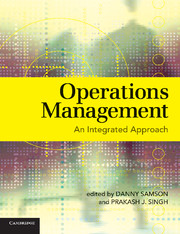Book contents
- Frontmatter
- Contents
- List of Contributors
- Preface
- Acknowledgements
- Part I Operations within Organisations – Building Blocks
- Part II Approaches to Understanding OM
- Part III Moving Forward with OM – Creating Competitive Advantage
- Part IV Challenges and Opportunities in Operations
- Part V Case Studies
- 1 Innovation in the Biotechnology Sector: The Case of IDT Australia
- 2 New Zealand King Salmon: Value-Chain Innovation
- 3 Pilila Clothing Company Goes Lean
- 4 From Singapore to the World: Port Management in Singapore
- 5 Striving for Operations Excellence within Queensland Rail Supply Division
- 6 Should I Stay or Should I Go? Shiraishi Garments Company
- 7 Towards a Green Supply Chain: Toyota Australia
- 8 Process Analyses and Improvement at Bartter Enterprises
- 9 Operations Challenges at Firth Industries Limited, Wellington Division
- 10 Ford Motor Company: Moving Forward in Australia
- 11 Technology Transfer at Hero Honda
- 12 Why Is the Patient Resident Time so Long?: The Case of St Martin's and Charity Private Hospital
- Index
3 - Pilila Clothing Company Goes Lean
Published online by Cambridge University Press: 05 June 2012
- Frontmatter
- Contents
- List of Contributors
- Preface
- Acknowledgements
- Part I Operations within Organisations – Building Blocks
- Part II Approaches to Understanding OM
- Part III Moving Forward with OM – Creating Competitive Advantage
- Part IV Challenges and Opportunities in Operations
- Part V Case Studies
- 1 Innovation in the Biotechnology Sector: The Case of IDT Australia
- 2 New Zealand King Salmon: Value-Chain Innovation
- 3 Pilila Clothing Company Goes Lean
- 4 From Singapore to the World: Port Management in Singapore
- 5 Striving for Operations Excellence within Queensland Rail Supply Division
- 6 Should I Stay or Should I Go? Shiraishi Garments Company
- 7 Towards a Green Supply Chain: Toyota Australia
- 8 Process Analyses and Improvement at Bartter Enterprises
- 9 Operations Challenges at Firth Industries Limited, Wellington Division
- 10 Ford Motor Company: Moving Forward in Australia
- 11 Technology Transfer at Hero Honda
- 12 Why Is the Patient Resident Time so Long?: The Case of St Martin's and Charity Private Hospital
- Index
Summary
The textile industry has all but evaporated from Australia and New Zealand over recent decades. How might it be possible to counter the low wages and huge scale of operations in countries such as China, and remain viable in this industry in Australia or New Zealand?
Box cs3.1: Productivity Commission review report excerpt
The Textiles, Clothing and Footwear (TCF) sector in Australia today is very different from that in the past. Traditionally, local activity was characterised by a series of manufacturing processes, with firms along the supply chain purchasing inputs from (mainly local) upstream suppliers and selling outputs to (mainly local) downstream customers. High tariffs and quota protection ensured the continued viability of firms along the chain, restricted the ability to source from competing offshore suppliers and reduced the incentive to find new (export) markets. Retailers played a largely passive role in selling final products designed and supplied by manufacturers with limited direct contribution to purchasing or production decisions …
In recent years, however, competition from emerging low-wage production centres, slowing growth in domestic consumer demand, large reductions in domestic assistance and increased concentration in retailing have collectively placed new pressures on local TCF manufacturers. Many firms have left the sector, while others have rationalised, merged, and pursued new sourcing strategies to survive. As a result, aggregate domestic TCF manufacturing activity has contracted and import penetration has risen sharply. […]
- Type
- Chapter
- Information
- Operations ManagementAn Integrated Approach, pp. 435 - 439Publisher: Cambridge University PressPrint publication year: 2008



